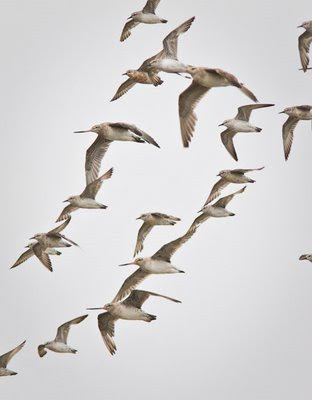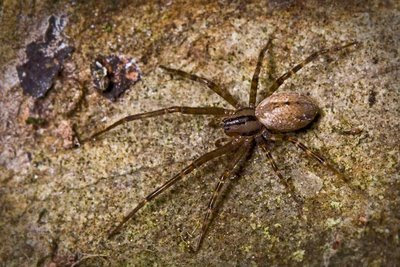A cold wind sweeps the Manawatu estuary, bringing a few light spots of rain from the overcast sky. The tide rises visibly, creeping across the mud flats, beginning to encircle the flock of bar-tailed godwits. A handful of birds lifts into the air, then more join them, then all but a few stragglers take to the wing and fly towards their high tide roost on the beach on the far side of the flats. As they recede into the grey distance the individuals disappear into the collective movement of wingbeats and the arc of flight; the cloud and the flock begin to merge.
Jesse Conklin looks up from the spotting scope. He seems thoughtful, slightly pensive, somewhere in the nebulous region between puzzled and concerned.
“A lot of birds are missing,” he says.
He's counted 178 birds, but last week more than 200 had occupied the estuary. The usual places small groups or stragglers might be hiding are devoid of birds. Jesse should know where to look—barring midwinter, he's here every week; he was waiting when the first godwits arrived in spring after their astonishing 11,500 km non-stop

flight from Alaska; he watched them all last summer until the last birds rose into the air and headed north-west to a stop-over on the shores of the Yellow Sea and eventually on to their breeding grounds back in Alaska.
The spring flight from Alaska to New Zealand is the longest recorded non-stop flight of any bird. The flight takes about nine days; not bad for a bird that averages about the weight of a can of beer (roughly 350 g). Elite human athletes can maintain an equivalent effort for only about one hour; you or I might manage 10–15 minutes before collapsing. The birds do have a singular advantage, though. Shortly before they take to the air their digestive system begins to shrivel—anything not essential for the flight atrophies; every gram might make the difference between a safe arrival and death.
Why do they do it? At first the answer seems obvious—during winter, Alaska's locked under ice and snow. Stay late and if the cold doesn't kill you starvation will. But why not fly to the Tropics? Why fly to the other end of the Earth—New Zealand?
Jesse shrugs.
“Good question,” he says. “We have a few theories, but we don't know for sure. The Tropics are dangerous places — lots of predators, parasites, diseases, and competition. It might simply be safer, despite the effort, for them to fly all the way here. Or, their adaptations for the Arctic cold might make it too difficult for them to survive tropical heat.”
It's the usual story. The more we learn, the more questions the knowledge raises. For example, bands on the birds' legs showed individuals returned to the same place each year.
“We now know they have very high site fidelity,” Jesse says. “Manawatu estuary birds return to the Manawatu estuary; Miranda birds return to Miranda, and so on. But we don't know if there's a genetic component. We don't know

if the offspring of Miranda birds migrate to Miranda, for example, or whether they choose somewhere else—and if they do choose somewhere else, why, and how?”
A group of godwits appears from somewhere and circles the roosting flock before settling down with them. Jesse turns back to the spotting scope and resumes counting, the clicking of the mechanical counter sounding like another kind of bird. There's no shortage of those, either. Red knots mingle with the godwits; a few of the ubiquitous black-backed and red-billed gulls fly overhead, the larger black-backs spreading a flutter of agitation through the godwit flock. White-fronted and Caspian terns cluster near the water's edge, the big, powerfully built caspians looking like rugby players among a group of dancers. A spoonbill flies upriver and skylarks hang, fluttering and singing above the marram and lupins from where a pheasant calls repeatedly. A kahu cruises on the far side of the river where tight, gnarled, wind-shorn trees rise beyond a patchwork of mud flats and rushes.
The rarest bird here is also the least conspicuous. Five thrush-sized wrybills rest in the shelter of a vehicle track in the sand, each bird resting on one leg, each with its unique, sideways-curved bill tucked under a wing. Soon they'll migrate back to the South Island. A few non-breeding birds remain in the North Island, but most return to the wide, braided Canterbury and Otago riverbeds to breed. New Zealand's—and therefore the world's—entire population totals just 4–5000 birds. But Canterbury farmers are clamouring for more water for dairying and to irrigate crops which, as droughts become more frequent and more severe, are harder to grow. Expanded irrigation schemes might keep these

types of agriculture viable for a while longer, giving farmers the chance to find forms better suited to the changing climate, but not all farmers are willing or able to adapt, preferring to demand still more water from the rivers—the only home the wrybills have to rear their young.
Right here, though, there's no shortage of water. The tide nears its peak; the sea fights the relentless flow of the evil olive-brown Manawatu with its shameful load of agricultural run-off and effluent dumped daily from the Fonterra factory not far upstream. This is not water one would swim in, let alone drink. What impact does it have on the birds and other wildlife living in and on the estuary? Sometimes one prefers not to know, but the thought arises: what we do here affects birds that spend half their lives in Alaska; our choices in Aotearoa directly influence the Alaskan environment.
...
How do the godwits know when to leave? Timing is especially crucial on the return journey from New Zealand to Alaska—leave too soon and the breeding grounds might still be covered in snow; too late and other godwits might have taken the best sites.
Researchers noticed that some male birds left early, still largely in their pale, non-breeding plumage, while others left later but with more developed, redder breeding plumage. Which birds might be more successful—those leaving early and claiming the best breeding sites, or those leaving later and arriving later but with more attractive plumage? And what about birds that leave early but take a break in Asia, eventually arriving in Alaska in similar breeding condition to the late-leaving birds?
“It gets even more complicated,” Jesse says. “Birds in southwest Alaska can start breeding up to 3–4 weeks earlier than those on the North Slope, which thaws later. Birds heading for the northern sites have to wait an extra month

for their breeding grounds to thaw, so why not go later and grow more breeding plumage? In other words, the late-leaving, redder males may simply be northern breeders.”
Although he's still a month short of one full year of collecting data, Jesse already has some insights into these and other questions. He's confirmed that male birds do vary greatly in the state of their breeding plumage at the time they depart. More information comes from tiny dataloggers fitted to some birds; these record changing daylight levels, and from the estimated times of sunrise and sunset, latitude and longitude can be estimated to within roughly 150 km—accurate enough to determine how long a bird stayed at the Yellow Sea feeding grounds, and roughly where it settles to breed. As the data accumulate, he might finally be able to say whether or not the late-departing, redder birds do indeed breed further north.
...
In the pub a few days later, Jesse grins.
“Saturday was one of the best days ever for recording data,” he says. “When the flock took off I got photos showing full wingtips in 31
colour-banded birds.”
Photography, as well as other recent technological developments like the miniscule dataloggers, is vital for Jesse's study. Beautiful photos aren't his aim (although he has plenty of those)—it's the information in the photos that's important. Wingtips let him gauge the stage of the bird's moult, but shots in flight are seldom useful because the legs are tucked up so the bands are hidden and the individual can't be identified. It's that moment

where they're stretching their wings to take flight, or lowering their legs to land—when leg bands and wingtips are visible in the same photo—that delivers the data. Given the total number of colour-banded godwits on the estuary is about 55–60, his high spirits are understandable. Information on half the birds in just one session seems worth celebrating.
Photos record that crucial information about the degree of development of breeding plumage. He can also score the condition of the bird from a side-on photo by comparing the area of the bird's body to the length of the lower leg (the tarsus); the length of the tarsus doesn't change, and it's known from measurements taken when the bird was banded. This lets Jesse determine the bird's condition when it leaves New Zealand — in other words, how well prepared it is for its migration. Between January and mid March, they'll add 60–70% to their body weight.
“A study like this wouldn't have been possible even a few years ago,” he says. “The recent advances in digital photography let me shoot hundreds of photos and extract the information from them in a way that just wouldn't have been feasible with film. The cost would have been prohibitive.”
...
A man and a woman with two small children come over to ask about the spotting scope and the birds. The small boy offers treasure in his hand — a small, dead crab. Places like this, with animals that fly and scuttle and burrow and swim; with the excitement of what might be under that driftwood log, still fascinate most children despite the temptations of TV and CGI. Maybe one day that small boy will carry on Jesse's work, helping us understand more about the astoundingly complex and beautiful world we share with these other lives—and on which we depend.
The man asks how many godwits live on the estuary.
“Do you know them by name?” he asks, in jest.
“I can identify most of them individually,”Jesse replies, and the man laughs and shakes his head. The couple and their children wander off, and Jesse returns to his counting. He looks up.
“That's it,” he says. “They're all here.”

 struggles to his feet, shuffles off towards the gents. Upright, he seems almost amorphous; the way he heaves himself along, awkward and rippling, suggests a trace of sea elephant in his heritage. When he returns he eases down onto the seat, flows outward over the plum plush, and resumes his contemplation of the dregs on the table. The logo on the glass identifies it as Fuller's London Pride.
struggles to his feet, shuffles off towards the gents. Upright, he seems almost amorphous; the way he heaves himself along, awkward and rippling, suggests a trace of sea elephant in his heritage. When he returns he eases down onto the seat, flows outward over the plum plush, and resumes his contemplation of the dregs on the table. The logo on the glass identifies it as Fuller's London Pride. knowing that'll never happen. Maybe he's just happy with his life, happy to sit in a corner on his own and enjoy a pint and then another. And then another, as the haze of contentment and goodwill thickens and settles over him. The world is fine, really—all that constant striving just makes a body anxious and highly strung.
knowing that'll never happen. Maybe he's just happy with his life, happy to sit in a corner on his own and enjoy a pint and then another. And then another, as the haze of contentment and goodwill thickens and settles over him. The world is fine, really—all that constant striving just makes a body anxious and highly strung.



































